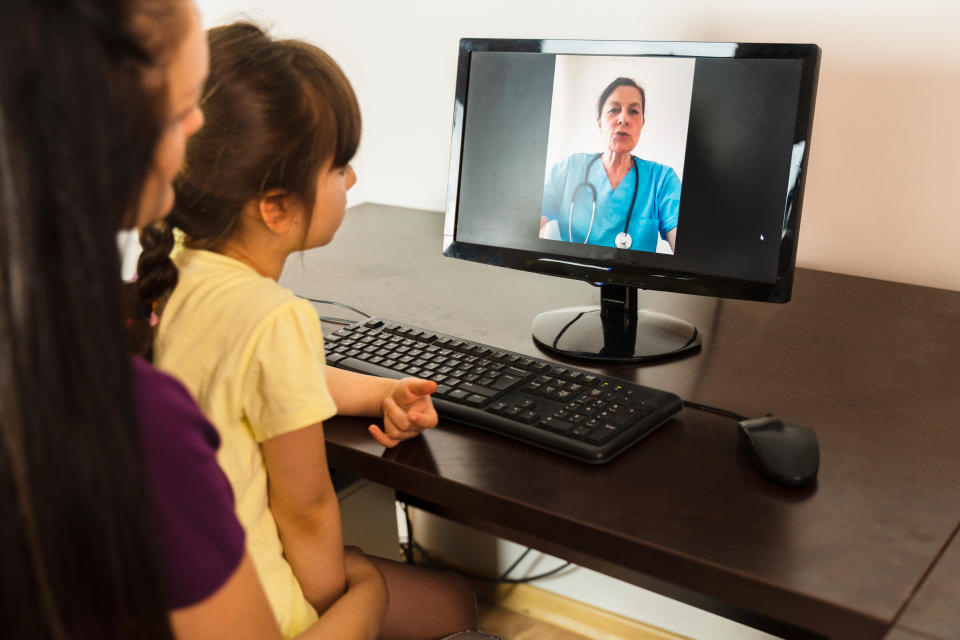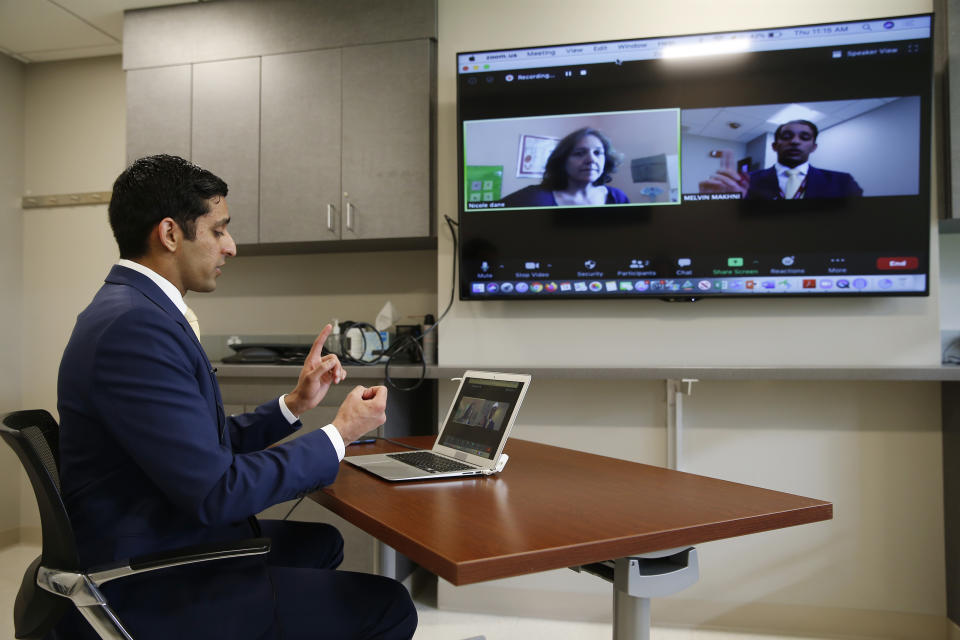Symptoms of COVID-19? Here's what you can do right now
Yahoo Life is committed to finding you the best services to help improve your life. We may receive a share from purchases made via links on this page. Pricing and availability is subject to change.

Developing symptoms of COVID-19 is understandably terrifying. And, if you don’t have a primary care physician or you’re nervous to go to your doctor’s office or local hospital, it’s hard to know what to do.
That’s where telehealth comes in. Many doctor’s offices have shifted to providing healthcare through video chat or over the phone during the pandemic. For patients who don’t already have a provider, services like Amwell, one of the top telehealth platforms in the country, allow for quick and easy access to a doctor without a long wait time, and it’s relatively inexpensive for those who do not have health insurance coverage.
Telehealth isn’t a new thing—but its use has spiked dramatically since the pandemic. A report this month by FAIR Health, a national, independent nonprofit, found telehealth claims increased 8,336 percent between April 2019 and April 2020, due almost entirely to the effects of the pandemic lockdown. The result: telehealth is revolutionizing the medical community, not just with physicians but with mental health experts, and making it easy for patients to get the medical assistance they need from the comfort of their own home.
“Since the onset of the pandemic, health systems had to adopt a new way of engaging with patients,” Dr. Arick Forrest, vice dean of Clinical Affairs at The Ohio State University Wexner Medical Center, tells Yahoo Life. “Having telehealth as an option is far better than avoiding or deferring care.”
What is telehealth, exactly?
Telehealth, also known as telemedicine, is the use of technology to provide and support healthcare from a distance, according to the National Institutes of Health (NIH).
One telehealth plaform, Amwell, provides patients with online access to doctors 24/7 with no appointment necessary, from any computer or mobile device. “We have seen 10, 20, 40 times the volume of telehealth operating on our servers,” Amwell CEO Roy Schoenberg tells Yahoo Life. “We have seen a little of a decline or relaxation in the end of May and beginning of June but unfortunately, it’s going back up again.”
After the start of the pandemic, Amwell hit a daily visit volume that was about 2,000 percent above what was expected for that time of year. During that time, it facilitated up to 45,000 visits a day on their platform.

How does this all work?
For telehealth-only companies like Amwell, the patient visits the Amwell web site, selects their health insurance company (if applicable), fills out some basic information and is quickly connected with a provider—no appointment necessary.
The visits can be similar to what you’d experience in an office. “I don’t want the quality of the visit [via telehealth] to be any different than the quality in the office,” Dr. Mia Finkelston, medical director at Amwell, tells Yahoo Life.
The telehealth process is slightly different everywhere. In some offices, a telehealth visit is set up like a “normal” in-office visit, Forrest says. Meaning, the patient calls the office and set up an appointment through a receptionist, or they schedule online. From there, they are given a secure link or phone number to use at the designated time to be connected with their provider.
Finkelston says that she and other care providers work hard to make patients feel comfortable. “Patients can share all they want,” she says. “Some people want to meet you and know you before they give you all that information.”
She says doctors can do more over telehealth than you’d think. “You can do a pretty good head and neck exam online,” she says. “You can’t do everything online, but you can get some ideas.”

How do COVID-19-related telehealth visits work?
In the case of COVID-19, doctors can assess symptoms in patients with milder illness, and then refer a patient to a testing site, if needed, Finkelston says. For patients with more severe symptoms, doctors can issue a “white glove” referral to hospital near the patient. “In this way, we can alert the hospital that a possible COVID-19 patient is coming so they can best prepare,” she says. “It’s important, especially during this time that we have coordinated care across care settings.”
As a whole, doctors can also help diagnose certain conditions, write prescriptions, and determine when an in-office appointment really is the best plan. “If you need an element that you cannot get through this, the patient needs to be seen in person,” Finkelston says.
But, she says, there are added perks to seeing a patient in their natural environment: “I will take note of what’s going on behind them—maybe they’re calling from their bed or there are kids running around. We see an element of patients that we don’t when they come in to the brick and mortar,” Finkelston says.
Mental health has also been a key issue during the pandemic, with a spike in anxiety, depression and substance abuse. Telehealth options can be great for both new patients and those who want to continue with care but are nervous about meeting in-person, Miami-area licensed clinical psychologist Erika Martinez, founder of Envision Wellness, tells Yahoo Life. “If they don’t need to be in person, telehealth is recommended,” she says.

Medical experts stress the importance of telehealth continuing as an option for patients.
“This is an important thing that needs to go forward,” Forrest says. “It has to be a part of our healthcare continuum in a way that’s both safe for patients but also to alleviate their concerns.”
Telehealth has the ability to break down geographic barriers which is crucial for patients, Forrest says. “A lot of rural communities can’t get access to the highest levels of healthcare,” he says. “It not just about seeing a primary care physician—it’s also about being able to talk to a specialist anywhere in the country.”
The increased use of telehealth during the pandemic has been an eye-opening experience for many. Schoenberg says his company regularly gets positive feedback from patients. “People just fall in love with this,” he says. “It allows us to really re-imagine how healthcare can be used by Americans.”
Ultimately, Forrest says that it’s important for the medical community to determine where telehealth falls in the care continuum. “It’s never going to fully replace a face-to-face encounter, but certainly telehealth can compliment it,” he says. “And that will ultimately improve the health of the population.”
Using a telehealth platform is easy: visit Amwell for additional information. Urgent care visits are $79 without insurance, but less expensive with a qualifying insurance plan. Mental health therapy ranges from $99 to $110 and there are additional options to meet with specialists like dermatologists, physical therapists, cardiologists and more.

See the latest coronavirus news and updates. According to experts, people over 60 and those who are immunocompromised continue to be the most at risk. If you have questions, please reference the CDC’s and WHO’s resource guides.
Read more from Yahoo Life
Want daily lifestyle and wellness news delivered to your inbox? Sign up here for Yahoo Life’s newsletter.